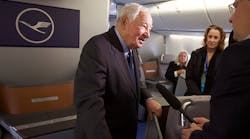Joe Sutter, the Boeing Co. engineer who ushered in the modern era of long-range travel by spearheading the 747 jumbo jet in the 1960s, died this week. He was 95.
“Joe lived an amazing life and was an inspiration — not just to those of us at Boeing, but to the entire aerospace industry,” Ray Conner, CEO of Boeing’s commercial airplane division, told employees in a message announcing Sutter’s death on Tuesday. “He personified the ingenuity and passion for excellence that made Boeing airplanes synonymous with quality the world over.”
The 747 was the capstone of a career spanning the twilight of piston-engine airliners to Boeing’s rivalry with Airbus Group four decades later. Starting with a swept-wing prototype in 1954 paving the way for the first U.S. jetliner, Sutter’s stamp was visible on aircraft through the 757 and 767 in the 1980s.
“He was a great engineer,” said Phil Condit, a former Boeing CEO who was once a member of Sutter’s 747 engineering group. “He dearly, dearly loved that airplane.”
Like the 747, Sutter was a throwback to a time when large, physical products defined U.S. innovation. With Boeing’s survival on the line, Sutter led a team that crafted the jet in less than two-and-a-half years, even as he defied the design wishes of the first buyer: Juan Trippe, the Pan American World Airways founder who was then the most powerful person in aviation.
“The aircraft was iconic, and so was he,” Richard Aboulafia, a Fairfax, Virginia-based aerospace analyst, said of Sutter. “It was a time of moonshots.”
Sutter retired in 1986 at age 65, as executive vice president in charge of Boeing’s commercial airplane engineering and product development. He served as a senior adviser emeritus for a quarter-century, regularly stopping by a Seattle-area office into his 90s.
“I have lots of ideas on how to develop good airplanes, and I will voice my comments to the fellas,” Sutter said in a 2010 interview. “They listen to me sometimes, and sometimes they don’t. But that’s the give-and-take of Boeing.”
Sutter helped shape the planes that cemented Boeing’s industry dominance while U.S. competitors faltered. He also didn’t shy from defying senior executives. Ordered to fire 1,000 engineers to save money on the 747, Sutter refused and demanded Boeing hire another 800 workers. He later wrote that he was certain he would be fired. He kept his job, and got extra manpower: “One on one, he was really neat,” Condit said in a 2015 interview. “He could be a bit bombastic in a group.”
Sutter served as second-in-command on the narrow-body 737, which was launched in the 1960s with prodding from Deutsche Lufthansa AG. The jet became Boeing’s best-seller.
Bigger, Faster
His next assignment was the plane envisioned as an aerial ocean liner by Pan Am, then the dominant global carrier. While Trippe wanted a revolutionary double-decker seating 400 people, Boeing saw it as a mere stopgap in the march toward a glittering vision of supersonic travel.
“If ever a program seemed set up for failure, it was mine,” Sutter wrote in his 2006 autobiography, “747: Creating the World’s First Jumbo Jet and Other Adventures From a Life in Aviation.”
To Sutter, Trippe’s insistence on a single-aisle design with two decks doomed the chances for the big plane’s success. Sutter held out for the single-deck, twin-aisle design -- then a novelty but now the standard in long-range jets. Tensions ran high, Sutter recalled, until the Pan Am chief visited factory mock-ups of the competing concepts. “You made the right decision,” Trippe told Sutter.
The hump-backed, four-engine 747 brought jet-setting to the mass market when it debuted in 1970, featuring globe-girdling range and more than double the capacity of Boeing’s next-largest aircraft.
Joseph F. Sutter was born to Frank and Rosa Sutter in Seattle on March 21, 1921, five years after Boeing was founded. He fell in love with aircraft as a child in Beacon Hill, a working-class neighborhood south of the city’s downtown overlooking the airfield where Boeing tested new planes.
He graduated from the University of Washington in 1943 with a bachelor’s degree in aeronautical engineering and married Nancy French before reporting for duty on the U.S. Navy destroyer escort Edward H. Allen.
Recruited by two planemakers after World War II, Sutter accepted a job with Douglas Aircraft Co. because it paid $210 a month, $10 more than Boeing. Then he took a short-term post with Boeing in February 1946 so his pregnant wife could deliver their first child in Seattle — and he never left.
His first assignment was to help work out glitches on the 377 Stratocruiser, Boeing’s last propeller-driven airliner. He went on to work on the Model 367-80, which led to the Boeing 707, the first U.S. jetliner, and then the 727, 737 and 747.
In his final Boeing post, as executive vice president leading engineering and product development for all commercial airplanes, Sutter oversaw the best-selling jumbo variant, the 747-400. Toulouse, France-based Airbus didn’t get its A380 superjumbo into service until 2007. He later served on the presidential commission that investigated the space shuttle Challenger disaster.
“He dedicated two lives” to aerospace, Nico Buchholz, a former Lufthansa executive who pushed for the most-recent 747 version, said in a 2014 interview.
A half century after Pan Am placed the initial jumbo order, Sutter’s creation has logged 1,543 sales. But with interest waning in four-engine models, Boeing earlier this summer conceded it might have to end the 747 program unless customer interest picks up.
In his book, Sutter recounted Charles Lindbergh’s response to the stately jetliner: “You know, this is one of the great ones.”
Sutter’s wife, Nancy, died in 1997. He is survived by three children: Gabrielle Sutter Young, Jonathan Sutter and Adrienne Sutter Craig.
By Julie Johnsson




